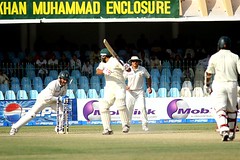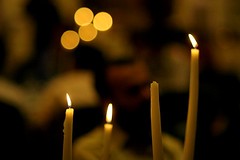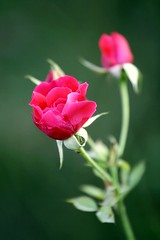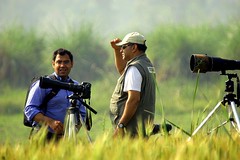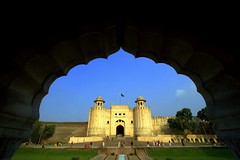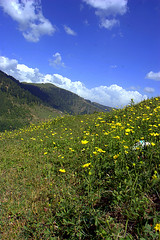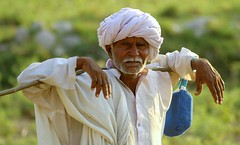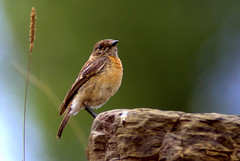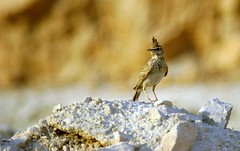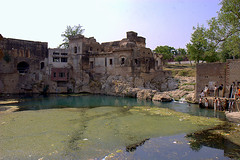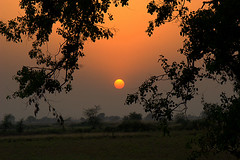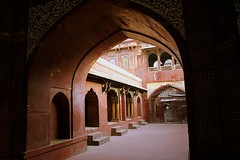People say a lot about Kashmir beauty that it is Paradise and heaven and the most beautiful place one can see on earth and it is my friends no doubt the most beautiful place that I have seen in my life time.
But ALAS!!! I can't cherish the beautiful memories of my tour to this beautiful place as I lost all what I shot over there. Let's have a look at what I have lost, most of the data from my Kahsmir got lost because I never had a backup with me. Only five pic are with me from that beautiful place..where I won't be able to go again at least in my lifetime.
Thursday, November 15, 2007
Friday, November 09, 2007
Omar Hayat Palace
Omar Hayat Mahal (Urdu: عمر حیات محل) is a 19th century wooden architectural wonder of Chiniot, a tehsil of the district of Jhang in Pakistan. It is also known as Gulzar Manzil.
Omar Hayat Palace is a five story building which stands in the heart of the city. Two upper stories were removed in 1993 due to heavy rainfall and storms which may have affected the adjoining buildings. It is a great tourist attraction for both local and foreign visitors.
History
Members of shaikh family migrated from Calcutta to Chiniot in the 18th or 19th century A.D. Sheikh Omar Hayat who was a successful trader born in a middle class family. He decided to construct a magnificent palace for his newborn son in 1923.
Syed Hassan Shah was assigned the task of palace's construction. He gathered many famous artisans from different places who continued working day and night for 10 ten years. Rahim Bakhsh Pirjha and Elahi Bakhsh Pirjha who were masters in manabat kari did wood carving. Gazeteer Vol XXXII, Jhang district 1929 states, "The house built by Sheikh Omar Hayat is a sort of local wonder, as it cost more than Rs 200,000 to make and rises high above all other buildings of area". The construction of the palace completed in 1935 and Mr Hayat expired in same year just a couple of months before its completion.
History claims that Mr Hayat's only son Gulzar Muhammad's marriage in 1938 brought an ironic twist of fate in the shape of death . He (Gulzar) was found dead in the palace the very next day of his marriage. The news of son’s death lofted loads of grief on mother who died remembering him. Both the mother and the son were buried in the courtyard of the ground floor of the palace.
Mr Hayat's relatives left the palace thinking it as a subject to bad luck, while servants continued living for a couple of years and then parted from it. An orphanage was established by some religious leaders and then it was evacued when its top story collapsed. Next came the Qabza groups who got shops and houses constructed on the piece of land lying next to it.
Architecture of the palace
Beautiful carvings on Roof and walls.The palace's building is perhaps the last of Mughal’s architectural style, or a Mughal Revival building ("revival" buildings are interpretations of an old architectural style by people of a later era). Unique carving cuts on the doors, windows and jhirokas reflect a colour of their own. The roofs, balconies, stairways, terrace and the stucco designs make a perfect interior. The facade of the building is decorated with a fine inlay of bricks, the dazzling shine of marble and picturesque shades help it rank among the great palaces of Mughal era landlords.
Recent status
Later on this placed was occupied by Qabza mafia who destroyed most of the building However seeing death of its glory in 1989, Athar Tahir, the then deputy commissioner of Jhang , took the palace into his custody. He removed the encroachments and started its renovation with an expenditure of Rs1,700,000.
Cultural centre
It was handed over to local municipal committee and a library, cultural centre and a museum were new additions which regained some vigour. A rare collection of thousands of books and subscription for seven dailies was introduced to learners and It was publicly opened the then Punjab Governor, Mian Azhar.
Recent condition
In Year 1997 the municipal committee refused to bear the expenses of the latest achievements and terminated the subscription of newspapers and other reading material.
It was later handed over to auqaf dpartment in year 1998 which also failed to improve its condition . The situation is getting worse by day. The library has been closed while the reading room is standing without its assets. It was only in 1989 when the building was last looked worth renovation.
At present the palace is very much out of sorts. Its walls have developed cracks rainy water pours in. The woodwork has lost colour. If the situation does not soon be handled in good manner, days are not far when the city will lose one of its historical monuments.
Omar Hayat Palace is a five story building which stands in the heart of the city. Two upper stories were removed in 1993 due to heavy rainfall and storms which may have affected the adjoining buildings. It is a great tourist attraction for both local and foreign visitors.
History
Members of shaikh family migrated from Calcutta to Chiniot in the 18th or 19th century A.D. Sheikh Omar Hayat who was a successful trader born in a middle class family. He decided to construct a magnificent palace for his newborn son in 1923.
Syed Hassan Shah was assigned the task of palace's construction. He gathered many famous artisans from different places who continued working day and night for 10 ten years. Rahim Bakhsh Pirjha and Elahi Bakhsh Pirjha who were masters in manabat kari did wood carving. Gazeteer Vol XXXII, Jhang district 1929 states, "The house built by Sheikh Omar Hayat is a sort of local wonder, as it cost more than Rs 200,000 to make and rises high above all other buildings of area". The construction of the palace completed in 1935 and Mr Hayat expired in same year just a couple of months before its completion.
History claims that Mr Hayat's only son Gulzar Muhammad's marriage in 1938 brought an ironic twist of fate in the shape of death . He (Gulzar) was found dead in the palace the very next day of his marriage. The news of son’s death lofted loads of grief on mother who died remembering him. Both the mother and the son were buried in the courtyard of the ground floor of the palace.
Mr Hayat's relatives left the palace thinking it as a subject to bad luck, while servants continued living for a couple of years and then parted from it. An orphanage was established by some religious leaders and then it was evacued when its top story collapsed. Next came the Qabza groups who got shops and houses constructed on the piece of land lying next to it.
Architecture of the palace
Beautiful carvings on Roof and walls.The palace's building is perhaps the last of Mughal’s architectural style, or a Mughal Revival building ("revival" buildings are interpretations of an old architectural style by people of a later era). Unique carving cuts on the doors, windows and jhirokas reflect a colour of their own. The roofs, balconies, stairways, terrace and the stucco designs make a perfect interior. The facade of the building is decorated with a fine inlay of bricks, the dazzling shine of marble and picturesque shades help it rank among the great palaces of Mughal era landlords.
Recent status
Later on this placed was occupied by Qabza mafia who destroyed most of the building However seeing death of its glory in 1989, Athar Tahir, the then deputy commissioner of Jhang , took the palace into his custody. He removed the encroachments and started its renovation with an expenditure of Rs1,700,000.
Cultural centre
It was handed over to local municipal committee and a library, cultural centre and a museum were new additions which regained some vigour. A rare collection of thousands of books and subscription for seven dailies was introduced to learners and It was publicly opened the then Punjab Governor, Mian Azhar.
Recent condition
In Year 1997 the municipal committee refused to bear the expenses of the latest achievements and terminated the subscription of newspapers and other reading material.
It was later handed over to auqaf dpartment in year 1998 which also failed to improve its condition . The situation is getting worse by day. The library has been closed while the reading room is standing without its assets. It was only in 1989 when the building was last looked worth renovation.
At present the palace is very much out of sorts. Its walls have developed cracks rainy water pours in. The woodwork has lost colour. If the situation does not soon be handled in good manner, days are not far when the city will lose one of its historical monuments.
Tuesday, October 30, 2007
Kashmir
My Kashmir tour in summer this month was a learning experience from every angle. I enjoyed every bit of it, I missed every bit of home, family, friend and the lack of communication with everybody. I had the honors of visiting the places which are still PURE, unpolluted, natural, raw and virgin from the eyes of many. The fresh air, the natural enviornment, the greenery, the scenary, the people, the meals, the tea, the stay, the rest houses and Truck hotels all are still vivid in my mind.
This was my first longest photography and trekking tour of my life in which I learned a lot from the seniors, made friends, learned the new ways of experimenation, tried to improve the landscape photography, shot less than any of my tour but tried to be more mature in composition, subjects and photography approach.
I would surely miss this tour All my life
This was my first longest photography and trekking tour of my life in which I learned a lot from the seniors, made friends, learned the new ways of experimenation, tried to improve the landscape photography, shot less than any of my tour but tried to be more mature in composition, subjects and photography approach.
I would surely miss this tour All my life
Sunday, October 14, 2007
Inzimam ul Haq: Dazzling, delicate; a reassuring presence
This is my Inzamam moment. At Mohali in 2005 , Pakistan's top order had imploded tragic-comically against an imposing deficit. 10 for 3 in the fifth and heavy defeat read the scoreboard when Inzamam walked out. If his mood has ever been dark at the crease, it was here.
Laxmipathy Balaji bowled the innings' sixth over; Inzamam struck three boundaries off the first three balls, none of them deserving their fate. The last I will remember till I remember nothing else: from the back, the contours of his love handles visible, he gently hunched forward. As the left heel landed, bat met ball, a forward push, no more, but mid-off never had a chance. His 86 was unusually hurried, and though men below him saved the Test, without Inzamam they had nothing.
Others will remember other shots, other days: a World Cup semi-final six; the last-ball poke past point in Ahmedabad; the triple; a Karachi hundred against India; the Multan escape. But they all speak only one truth, that when Pakistan absolutely needed him, he pulled through. Not always, because he was needed most days and he wasn't one for the nine-to-five life. But much more often than not, he did and that is precious.
The environment, the personality, didn't exist for him to become a glam lone ranger like Lara. Javed Miandad, Salim Malik, Mohammad Yousuf and Younis Khan all helped ease the burden, not always equally. Neither was he as driven, as ruthless as Tendulkar, Kallis or Ponting. A louder media might have helped, but that hunger would've done so more. Against pace, on his day, he was the equal of any and the same reflexes made him probably the best slip Pakistan has had.
A touch distasteful maybe to recall what he wasn't - because what he was, was special enough - but in a time of such batting excess, it is important to situate him. The first time his average reached 50 was in his 92nd Test. Only from his 100th, marked with a century and win , did he sustain it. Tragedy is, it fell below the milestone in his final Test.
Aamer Sohail, never one to call a spade by any other name, got to the core of the batsman Inzamam: a great player, a rare blend of force and delicacy yes, but could he have done even more? Ten hundreds in 378 ODIs says maybe, as do ordinary records against South Africa and Australia, the best bowling attacks of his time.
Two of his finest came against the best: an unbeaten fifty against Australia to chase Pakistan's highest Test target and a 92 the equal of any century at Port Elizabeth . Seventeen match-winning hundreds out of 25, among the best rates ever, also settles many debates. Batting so far down the ODI order hurt his conversion rate, but in a stiff chase, the heat on, Inzamam was the sharpest tack, capable of innings chiseled from ice.
This is all to nitpick, of course, especially as Pakistan has less batting heroes than it should. Much more convenient to say that alongside Javed Miandad he is the greatest Pakistani batsman and undoubtedly, one of the best, most compelling of modern batsmen.
Captaincy brought out the human in Inzamam, despite his reluctance for the post. He was a caricature before: aloo, overweight, loves a nap, (and his food even more), comedy runner, loses runs when he loses pounds, hits fans. He probably didn't mind it, because nobody minds goodwill, sympathy and endearment the world over.
His dry, sharp wit, already known to teammates, emerged when he had to address press conferences. He was also honest: asked to assess an under-utilised bowler's performance once, he replied, "If he had performed I could've told you."
The Bangalore win, on the last afternoon to level the series, was the making of Inzamam as leader. The allsorts attack he used then would today be good, honest Twenty20 material. Yet somehow he tricked Mohammad Sami, Arshad Khan, Shahid Afridi and Danish Kaneria into believing they could dismiss the most frightening batsmen in the world. And they did. On the field, Inzamam was never more alert, more harassed, more proactive and under greater strain.
That sparked a 15-month period in which Pakistan prospered under Inzamam and Bob Woolmer. Suddenly Pakistan calmed down, came together. With the bat, Inzamam touched his peak; five hundreds in 11 Tests at over 80, as Pakistan beat England, India and Sri Lanka.
But subsequently decay set in. Inzamam's calm became inertia, he drifted from Woolmer and religion, glue one year, became distraction the next. That most human of all maxims, that power corrupts, afflicted him. As Pakistan stumbled out of the World Cup in an ugly daze, Inzamam was famously accused of being a dictator, haughty and a maulvi (preacher).
In truth, he did things this last year which he shouldn't be remembered by, notably a cranky, emotional, accusatory press conference. His last dismissal was strange, but in a career that long a blemish or two (an uneasy, indirect entanglement in matchfixing was another) is human.
With Inzamam departs the last of 1992, when Pakistan cricket was a different world. Not that it was stable before, but that world has since come undone. Inzamam didn't keep it all together; he couldn't for no one person could, but he was there through all of it, the highs, the lows, the thick, the thin: a reassurance. In that alone, there is greatness.
Laxmipathy Balaji bowled the innings' sixth over; Inzamam struck three boundaries off the first three balls, none of them deserving their fate. The last I will remember till I remember nothing else: from the back, the contours of his love handles visible, he gently hunched forward. As the left heel landed, bat met ball, a forward push, no more, but mid-off never had a chance. His 86 was unusually hurried, and though men below him saved the Test, without Inzamam they had nothing.
Others will remember other shots, other days: a World Cup semi-final six; the last-ball poke past point in Ahmedabad; the triple; a Karachi hundred against India; the Multan escape. But they all speak only one truth, that when Pakistan absolutely needed him, he pulled through. Not always, because he was needed most days and he wasn't one for the nine-to-five life. But much more often than not, he did and that is precious.
The environment, the personality, didn't exist for him to become a glam lone ranger like Lara. Javed Miandad, Salim Malik, Mohammad Yousuf and Younis Khan all helped ease the burden, not always equally. Neither was he as driven, as ruthless as Tendulkar, Kallis or Ponting. A louder media might have helped, but that hunger would've done so more. Against pace, on his day, he was the equal of any and the same reflexes made him probably the best slip Pakistan has had.
A touch distasteful maybe to recall what he wasn't - because what he was, was special enough - but in a time of such batting excess, it is important to situate him. The first time his average reached 50 was in his 92nd Test. Only from his 100th, marked with a century and win , did he sustain it. Tragedy is, it fell below the milestone in his final Test.
Aamer Sohail, never one to call a spade by any other name, got to the core of the batsman Inzamam: a great player, a rare blend of force and delicacy yes, but could he have done even more? Ten hundreds in 378 ODIs says maybe, as do ordinary records against South Africa and Australia, the best bowling attacks of his time.
Two of his finest came against the best: an unbeaten fifty against Australia to chase Pakistan's highest Test target and a 92 the equal of any century at Port Elizabeth . Seventeen match-winning hundreds out of 25, among the best rates ever, also settles many debates. Batting so far down the ODI order hurt his conversion rate, but in a stiff chase, the heat on, Inzamam was the sharpest tack, capable of innings chiseled from ice.
This is all to nitpick, of course, especially as Pakistan has less batting heroes than it should. Much more convenient to say that alongside Javed Miandad he is the greatest Pakistani batsman and undoubtedly, one of the best, most compelling of modern batsmen.
Captaincy brought out the human in Inzamam, despite his reluctance for the post. He was a caricature before: aloo, overweight, loves a nap, (and his food even more), comedy runner, loses runs when he loses pounds, hits fans. He probably didn't mind it, because nobody minds goodwill, sympathy and endearment the world over.
His dry, sharp wit, already known to teammates, emerged when he had to address press conferences. He was also honest: asked to assess an under-utilised bowler's performance once, he replied, "If he had performed I could've told you."
The Bangalore win, on the last afternoon to level the series, was the making of Inzamam as leader. The allsorts attack he used then would today be good, honest Twenty20 material. Yet somehow he tricked Mohammad Sami, Arshad Khan, Shahid Afridi and Danish Kaneria into believing they could dismiss the most frightening batsmen in the world. And they did. On the field, Inzamam was never more alert, more harassed, more proactive and under greater strain.
That sparked a 15-month period in which Pakistan prospered under Inzamam and Bob Woolmer. Suddenly Pakistan calmed down, came together. With the bat, Inzamam touched his peak; five hundreds in 11 Tests at over 80, as Pakistan beat England, India and Sri Lanka.
But subsequently decay set in. Inzamam's calm became inertia, he drifted from Woolmer and religion, glue one year, became distraction the next. That most human of all maxims, that power corrupts, afflicted him. As Pakistan stumbled out of the World Cup in an ugly daze, Inzamam was famously accused of being a dictator, haughty and a maulvi (preacher).
In truth, he did things this last year which he shouldn't be remembered by, notably a cranky, emotional, accusatory press conference. His last dismissal was strange, but in a career that long a blemish or two (an uneasy, indirect entanglement in matchfixing was another) is human.
With Inzamam departs the last of 1992, when Pakistan cricket was a different world. Not that it was stable before, but that world has since come undone. Inzamam didn't keep it all together; he couldn't for no one person could, but he was there through all of it, the highs, the lows, the thick, the thin: a reassurance. In that alone, there is greatness.
Thursday, September 20, 2007
This is the end...
Like this I will end one day............
These candles continue to give in life...
But they have a life and they finally end...
This is the start and the end....
Continued from where I Left...
Only If I had time to say What I wanted to say
Only If I had the right time to do what I wanted to Do...
I wish I would not have been like that today...
yes, I know and still confess..
I Love you
But I know that It is End...
End for me...
To Live like that without that bright candle in my life
To live without the light
Only To realize
My Biggest mistake in Life
Finally my life has took a huge turn that I have never anticipated in my whole life time. The results of taking a bad decision on my part of one of the most important things in my life has finally showed off. I just regret of what I have done and hope so that the better time will come.
These candles continue to give in life...
But they have a life and they finally end...
This is the start and the end....
Continued from where I Left...
Only If I had time to say What I wanted to say
Only If I had the right time to do what I wanted to Do...
I wish I would not have been like that today...
yes, I know and still confess..
I Love you
But I know that It is End...
End for me...
To Live like that without that bright candle in my life
To live without the light
Only To realize
My Biggest mistake in Life
Finally my life has took a huge turn that I have never anticipated in my whole life time. The results of taking a bad decision on my part of one of the most important things in my life has finally showed off. I just regret of what I have done and hope so that the better time will come.
Tuesday, September 18, 2007
Rose For...
Untitled....I can't reveal the name, but some one who gave my life a new meaning, a new direction. It was shot for her depicting the true feelings of my life.
Before her my life has been like the blurred rose which is in the background, her enterance has been like a fresh rose in the pciture which has given a new life, some new breath to it.
Thanks a lot for giving my life a new meaning and a new direction.
Before her my life has been like the blurred rose which is in the background, her enterance has been like a fresh rose in the pciture which has given a new life, some new breath to it.
Thanks a lot for giving my life a new meaning and a new direction.
Thursday, September 06, 2007
New lessons Learnt
My life has been changed, after touring the northern areas of Pakistan thrice this summer, I have explored what I wanted to in order to give a change my life from the monotony I have been passing through.
I learned a lot of lesson in the previous days, and the best among them is that
I learned a lot of lesson in the previous days, and the best among them is that
- Never underestimate any body and learn from everybody. Even from those who are inferior in work from you, learn from them, learn from the mistakes they do and try to avoid them as much as possible, and secondly look at the work who are superior to you. Learn from what they do and how they have been able to achieve a much better position than you. What makes them different and what is their working style. All these things will help in becoming a better professional.
- Always try to keep a standard of your work, set some high goals for yourself and try to achieve in the best possible ways. There is nothing worst than not been able to meet your own set standards.
- If you want to succeed, be Humble. Never let the ME thing enter in yourself.
I am sure that I will try to act upon these lessons that I have learned in my days that I have spend in mountains with some fellows.
Wednesday, May 30, 2007
Pros at Work
I was with these pros Dr. Adnan Qureshi and Wildlife Kosmos to visit head Balooki for shooting birds. These pros are excellent to say the least, wonderful in their work and committed to excellence. May some day I can work like them.
Tourism Scenario Mag Cover
Happy and proud moments for me.
My shot of Hiran MInar chosen to be on the cover of Toursim Scenario Int' Magazine.
My shot of Hiran MInar chosen to be on the cover of Toursim Scenario Int' Magazine.
Banjosa Lake, AJK
The early morning view of Banjosa Lake, AJK with my signatures.
Comments/Critics welcome
Comments/Critics welcome
Lahore Fort, Lahore, Pakistan
Another option For the cover of what is known to be my yet unnamed, untitled, un-arranged book on Pakistan.
Saturday, May 26, 2007
Tolipir
Tolipir is a very beautiful place in AJK ahead of Rawalakot. It is around 30 kms from Rawalakot and takes around one and half hour to reach there. The views on both sides of the road are breathtaking during the whole journey and one enjoys looking at the beautiful scenery. There are some rough tracks on the way as well which you can only pass if you have the courage and your car has the mettle to undergo from.
This particular view was shot from the top of a neighboring peak which was on our way before the Tolipir.
This particular view was shot from the top of a neighboring peak which was on our way before the Tolipir.
Tuesday, May 22, 2007
Channan Peer Mela
EVERY year, in the month of Feb and March Channan Peer Festival or Mela Channan Peer is held in Cholistan desert for six consecutive weeks. The fifth week is considered to be the most popular and most honored one. It attracts people from far and wide, who pray for welath and sons at the dune, just as they have done for thousands of years. Today thousands of Pilgrims come to Channan Peer to worship at the dune either by using Camels, horses or modern mode of transportation like tractors, trollies, jeeps and cars. It is a carnival season for all the pilgrims, who stay there for at least a night and camp, cook and eat together and sleep in the open sky as part of the traditions and ritual of the Channan Peer. The sacrifice of different animals is done in order to win the favors of Channan Peer in order to get the son and wealth.
It is one of the most celebrated occassion and people wait for it all the year, the whole desert takes a festive mood and happenings happen all over the desert. Other than pilgrims, visitors also come to visit the mela and enjoy the celebrations. This year the event was further supported by the district government of Behawalpur who gave a local holiday on the 5th Thursday of the festival so as to let people participate in it in a complete manner.
It is one of the most celebrated occassion and people wait for it all the year, the whole desert takes a festive mood and happenings happen all over the desert. Other than pilgrims, visitors also come to visit the mela and enjoy the celebrations. This year the event was further supported by the district government of Behawalpur who gave a local holiday on the 5th Thursday of the festival so as to let people participate in it in a complete manner.
Do you scare me?
HE was working in his field when i spot him from my car during my visit at Chakwal, Salt Range area. I picked up my camera and started taking his shots from my 400 mm f5.6 telelens. He was scared, he never knew what is gonna happen, He thought that I am gonna kill him with my telelens hidden in my car and pointing towards him.
Innocence
Taking potraits of children and people on street is most difficult as you don't know what waits ahead. It is difficult because you have less time to think and act, no time to change the lenses but all what you have to do is to catch the moment. This portarit of a young Kashmiri girl was shot on my recent tour to Banjosa Lake, AJK. We were on our car waiting for finding some good spot to do the sunset when we found a few children playing besides the road. We immediately stopped, asked the children to look at us and captured a few images from the car. I asked this beautiful girl to come at my side and stand, she was holding his brother in his hands and she gave me some good gestures. Thanks to my 28-105 f2.8 lens that was mounted at that time on my camera that I got a good DOF.
Common Stonechat
Stonechats:
The genus Saxicola, the stonechats or chats, is a genus of 14 species of small passerine birds restricted to the Old World. They are insectivores of open scrubland and grassland with scattered small shrubs.
Due to confusion of subspecies allocation, the name S. torquata was briefly used for the European species, the African Stonechat being S. axillaris.
Species list:
Whinchat, Saxicola rubetra
Stoliczka's Bushchat or White-browed Bushchat, Saxicola macrorhyncha
Hodgson's Bushchat or White-throated Bushchat, Saxicola insignis
Fuerteventura Chat or Canary Island Stonechat, Saxicola dacotiae
Chinijo Chat, Saxicola dacotiae murielae - extinct (early 20th century)
European Stonechat, Saxicola rubicola (previously S. torquata rubicola)
Siberian Stonechat or Asian Stonechat, Saxicola maura (previously S. torquata maura)
African Stonechat, Saxicola torquata
Reunion Stonechat, Saxicola tectes
White-tailed Stonechat, Saxicola leucura
Pied Bushchat, Saxicola caprata
Jerdon's Bushchat, Saxicola jerdoni
Grey Bushchat, Saxicola ferrea
White-bellied Bushchat or Timor Bushchat, Saxicola gutturalis
Buff-streaked Bushchat, Saxicola bifasciata
Scientific Classification:
Kingdom:Animalia
Phylum:Chordata
Class:Aves
Order:Passeriformes
Family:Muscicapidae
Genus:Saxicola (Bechstein, 1802)
References
Urquhart, Ewan & Bowley, Adam (2002): Stonechats. A Guide to the Genus Saxicola. Christopher Helm, London. ISBN 0-7136-6024-4
Wink, M.; Sauer-Gürth, H. & Gwinner, E. (2002): Evolutionary relationships of stonechats and related species inferred from mitochondrial-DNA sequences and genomic fingerprinting. British Birds 95: 349-355. PDF fulltext
The genus Saxicola, the stonechats or chats, is a genus of 14 species of small passerine birds restricted to the Old World. They are insectivores of open scrubland and grassland with scattered small shrubs.
Due to confusion of subspecies allocation, the name S. torquata was briefly used for the European species, the African Stonechat being S. axillaris.
Species list:
Whinchat, Saxicola rubetra
Stoliczka's Bushchat or White-browed Bushchat, Saxicola macrorhyncha
Hodgson's Bushchat or White-throated Bushchat, Saxicola insignis
Fuerteventura Chat or Canary Island Stonechat, Saxicola dacotiae
Chinijo Chat, Saxicola dacotiae murielae - extinct (early 20th century)
European Stonechat, Saxicola rubicola (previously S. torquata rubicola)
Siberian Stonechat or Asian Stonechat, Saxicola maura (previously S. torquata maura)
African Stonechat, Saxicola torquata
Reunion Stonechat, Saxicola tectes
White-tailed Stonechat, Saxicola leucura
Pied Bushchat, Saxicola caprata
Jerdon's Bushchat, Saxicola jerdoni
Grey Bushchat, Saxicola ferrea
White-bellied Bushchat or Timor Bushchat, Saxicola gutturalis
Buff-streaked Bushchat, Saxicola bifasciata
Scientific Classification:
Kingdom:Animalia
Phylum:Chordata
Class:Aves
Order:Passeriformes
Family:Muscicapidae
Genus:Saxicola (Bechstein, 1802)
References
Urquhart, Ewan & Bowley, Adam (2002): Stonechats. A Guide to the Genus Saxicola. Christopher Helm, London. ISBN 0-7136-6024-4
Wink, M.; Sauer-Gürth, H. & Gwinner, E. (2002): Evolutionary relationships of stonechats and related species inferred from mitochondrial-DNA sequences and genomic fingerprinting. British Birds 95: 349-355. PDF fulltext
Wednesday, May 16, 2007
Bird @ Chakwal, Pakistan
Finally back to basics i.e. Bird Photography. Shot during my visit to Salt Range areas.
Equipment:
Canon 20D, Sigma 400 mm f5.6 Handheld
Equipment:
Canon 20D, Sigma 400 mm f5.6 Handheld
Katas Raj Temples, Chakwal, Pakistan
Katasraj temple is a Hindu temple situated in Chakwal district of Punjab in Pakistan. Dedicated to Lord Shiva, the temple has existed since the days of Mahabharata and the Pandava brothers spent a substantial part of their exile at the site. Pakistan Government is considering nominating the temple complex for World Heritage Site status. It also proposes to spend about Rs 20 million in three phases for the restoration of the complex.
Another day draws to an end
The last pic of the tour at Chakwal when finally another day of my life draw to an end.
Mallot temples, pakistan
The Malot temples, built of local red sand stones of salt range mountains, are located located on the road leading to Malot village near Choi village. The road is linked with main Kalar kahar road from where it turns from Karuli Chawk towards Malot via Pakistan cement factory and Choi village along with coal mines. It is nine miles away in the south of Katas and same distance from Kalar kahar in the east. It is at the height of 3000 feet and the original spread of the fort was 2000 feet from east to west and 1500 feet from north to south. The inner most spread is 1000 by 500 feet. Gen Cunningham estimated the radius of 2.5 miles.
The Malot was also called Namrod and Ramrod. Gen Abbot has mentioned its name as Shah Garh or Shai Garh but Janjuas name d it Raj Garh. The name is after the King of MalDev or Malu. The Rajput history claims its name Malot from the word Malik-Kot as they believed that the title of Malik was given to the one who accepted annexation to the Muslim King of Delhi although in reward the Malik enjoyed the autonomous status with full sovereignty in the assigned area. The Mughal King Babur’s travelogue “Tuzkai-Babree” attests to the corollary of Malik-Kot, Mal-Kot and then Malot. According to Ghadholak Rajput archives the city of Delhi was built around 994 AD and Malot was built around 980 AD. Gen Cunningham found the Malot Fort and Temples in a very bad shape even in 1848.
The two present temples were looked after by the Brahman Bali Hindus till 1947. The Guru of Bali Hindus, Guru Tarlok Nath shrines were frequently visited by them. In the year 1527 Daulat khan Lodhi was forced by the royal forces of Mughal king Babur, to surrender. Mahan Singh, father of Maharaja Rangeet singh, also built a small fort here at Malot in early 19th century.
The access to Salt Range Mallot Temples Distt Chakwal is as follows,
Coming from Lahore / south-western parts of Pakistan or from Islamabad / Rawalpindi we will travel on motorway till Kallar Kahar interchange. From Kallar Kahar interchange toll plaza we will be taking turn going towards Choa Saidan Shah Distt Chakwal, leaving the other turn going towards “Soon-Sakeisar valley. From there about 2km away there is a right turning called “Karuli chowk” from here the road will lead us to Choi village after passing near by newly established Pakistan Cement Factory. After Choi village we will reach Mallot village where Mallot Temples are located which were built circa 900-1000 years ago. The total distance will be around 35-40 minutes from “Karuli chowk” to Mallot village.
The Malot was also called Namrod and Ramrod. Gen Abbot has mentioned its name as Shah Garh or Shai Garh but Janjuas name d it Raj Garh. The name is after the King of MalDev or Malu. The Rajput history claims its name Malot from the word Malik-Kot as they believed that the title of Malik was given to the one who accepted annexation to the Muslim King of Delhi although in reward the Malik enjoyed the autonomous status with full sovereignty in the assigned area. The Mughal King Babur’s travelogue “Tuzkai-Babree” attests to the corollary of Malik-Kot, Mal-Kot and then Malot. According to Ghadholak Rajput archives the city of Delhi was built around 994 AD and Malot was built around 980 AD. Gen Cunningham found the Malot Fort and Temples in a very bad shape even in 1848.
The two present temples were looked after by the Brahman Bali Hindus till 1947. The Guru of Bali Hindus, Guru Tarlok Nath shrines were frequently visited by them. In the year 1527 Daulat khan Lodhi was forced by the royal forces of Mughal king Babur, to surrender. Mahan Singh, father of Maharaja Rangeet singh, also built a small fort here at Malot in early 19th century.
The access to Salt Range Mallot Temples Distt Chakwal is as follows,
Coming from Lahore / south-western parts of Pakistan or from Islamabad / Rawalpindi we will travel on motorway till Kallar Kahar interchange. From Kallar Kahar interchange toll plaza we will be taking turn going towards Choa Saidan Shah Distt Chakwal, leaving the other turn going towards “Soon-Sakeisar valley. From there about 2km away there is a right turning called “Karuli chowk” from here the road will lead us to Choi village after passing near by newly established Pakistan Cement Factory. After Choi village we will reach Mallot village where Mallot Temples are located which were built circa 900-1000 years ago. The total distance will be around 35-40 minutes from “Karuli chowk” to Mallot village.
Dark Periods
From Darkness to light
A trance of one's life in which when all doors are closed and one is left in darkness, it is light that gives one direction, a moment to live and a meaning of life.
To all those dark moments of my life which have eventually been lightened in one way or the others. To All those people in my people who have inspired me, left me all alone and have given meanings to my life thus making my life more meaningless, To all those dreams in my life that have been left uncomplete!!! I dedicate this shot.
A trance of one's life in which when all doors are closed and one is left in darkness, it is light that gives one direction, a moment to live and a meaning of life.
To all those dark moments of my life which have eventually been lightened in one way or the others. To All those people in my people who have inspired me, left me all alone and have given meanings to my life thus making my life more meaningless, To all those dreams in my life that have been left uncomplete!!! I dedicate this shot.
Sunday, May 13, 2007
Masjid Wazir Khan
My first visit to Masjid Wazir, an architectural wonder of Muslim times in Lahore near Dehli Gate grabbed my attention due to its beautiful architecture.
I spot this beautiful, calm and historical place and decided to spend sometime looking at the architecture and the way Mughals worked over it. This particular image was shot by Sony Cybershoot.
After the advent of Islam in sixth century AD a new style of construction came into being which was later known as Islamic Architecture. It has its won significance and a powerful influence all over the world. In Asia we see many such buildings in Indo-Pak, Iran, Turkey, China, Arabian countries and Central Asian States.
In our region the Mughal period can be said as the golden era which apart from other important events, the art of construction and architecture reached its climax especially in the regime of Shah Jehan.
There are several forts, castles, palaces, gardens, tombs and mosques, which portray this art. In this context, Taj Mahal at Agra is an example of no match, mosques are also one of the most interesting buildings in Islamic World. Among several famous mosques like, Badshahi Masjid, Moti Masjid, Sunehri Masjid at Lahore, Shahi Masjid at Chiniot, Masjid Mohabat Khan at Peshawar Shahi Masjid at Delhi. Masjid Wazir Khan at Lahore is one such glorious buildings of the Mughal Era, constructed by Ilam-ud-Deen Ansari, the Governor of Punjab under Shah Jehan, the successor of Jahangir.
The Construction of this mosque started in 1934 and took 7 years for completion. The glorious mosque is made of bricks and faced with gaily-coloured glazed mosaic tiles. It is justifiably famous for the colourful fresco and tile decorations, which adorn both interior and exterior of the building. The use of inlaid pottery decoration in the wall panelling is remarkable. Watching closely, it reveals that each section is a separate piece of tile and the work in strictly inlay and not painted; small bricks laid in Kankar time with a sprinkling of red sandstone. The grills of the mosque are in terra cotta.
The mosque is not a huge as the Shahi Mosque of Lahore. The total area of the mosque is 279.5' x 159', while the hall is 131.3' x 42'. On the corners of the building three are elegantly erected octagonal minarets measuring 107' in height. These minarets are decorated with mosaic tiles and are an outstanding features of art. On request one may get the permission to climb 69 steps of a minaret to the place of muezzin. The gallery offers a superb panorama of the old city.
This living legacy is an intricate masterpiece of work, which portrays great devotion and sincerity of its builders and designers. To keep this heritage in its pristine beauty is the need of time.
I spot this beautiful, calm and historical place and decided to spend sometime looking at the architecture and the way Mughals worked over it. This particular image was shot by Sony Cybershoot.
After the advent of Islam in sixth century AD a new style of construction came into being which was later known as Islamic Architecture. It has its won significance and a powerful influence all over the world. In Asia we see many such buildings in Indo-Pak, Iran, Turkey, China, Arabian countries and Central Asian States.
In our region the Mughal period can be said as the golden era which apart from other important events, the art of construction and architecture reached its climax especially in the regime of Shah Jehan.
There are several forts, castles, palaces, gardens, tombs and mosques, which portray this art. In this context, Taj Mahal at Agra is an example of no match, mosques are also one of the most interesting buildings in Islamic World. Among several famous mosques like, Badshahi Masjid, Moti Masjid, Sunehri Masjid at Lahore, Shahi Masjid at Chiniot, Masjid Mohabat Khan at Peshawar Shahi Masjid at Delhi. Masjid Wazir Khan at Lahore is one such glorious buildings of the Mughal Era, constructed by Ilam-ud-Deen Ansari, the Governor of Punjab under Shah Jehan, the successor of Jahangir.
The Construction of this mosque started in 1934 and took 7 years for completion. The glorious mosque is made of bricks and faced with gaily-coloured glazed mosaic tiles. It is justifiably famous for the colourful fresco and tile decorations, which adorn both interior and exterior of the building. The use of inlaid pottery decoration in the wall panelling is remarkable. Watching closely, it reveals that each section is a separate piece of tile and the work in strictly inlay and not painted; small bricks laid in Kankar time with a sprinkling of red sandstone. The grills of the mosque are in terra cotta.
The mosque is not a huge as the Shahi Mosque of Lahore. The total area of the mosque is 279.5' x 159', while the hall is 131.3' x 42'. On the corners of the building three are elegantly erected octagonal minarets measuring 107' in height. These minarets are decorated with mosaic tiles and are an outstanding features of art. On request one may get the permission to climb 69 steps of a minaret to the place of muezzin. The gallery offers a superb panorama of the old city.
This living legacy is an intricate masterpiece of work, which portrays great devotion and sincerity of its builders and designers. To keep this heritage in its pristine beauty is the need of time.
Subscribe to:
Posts (Atom)



